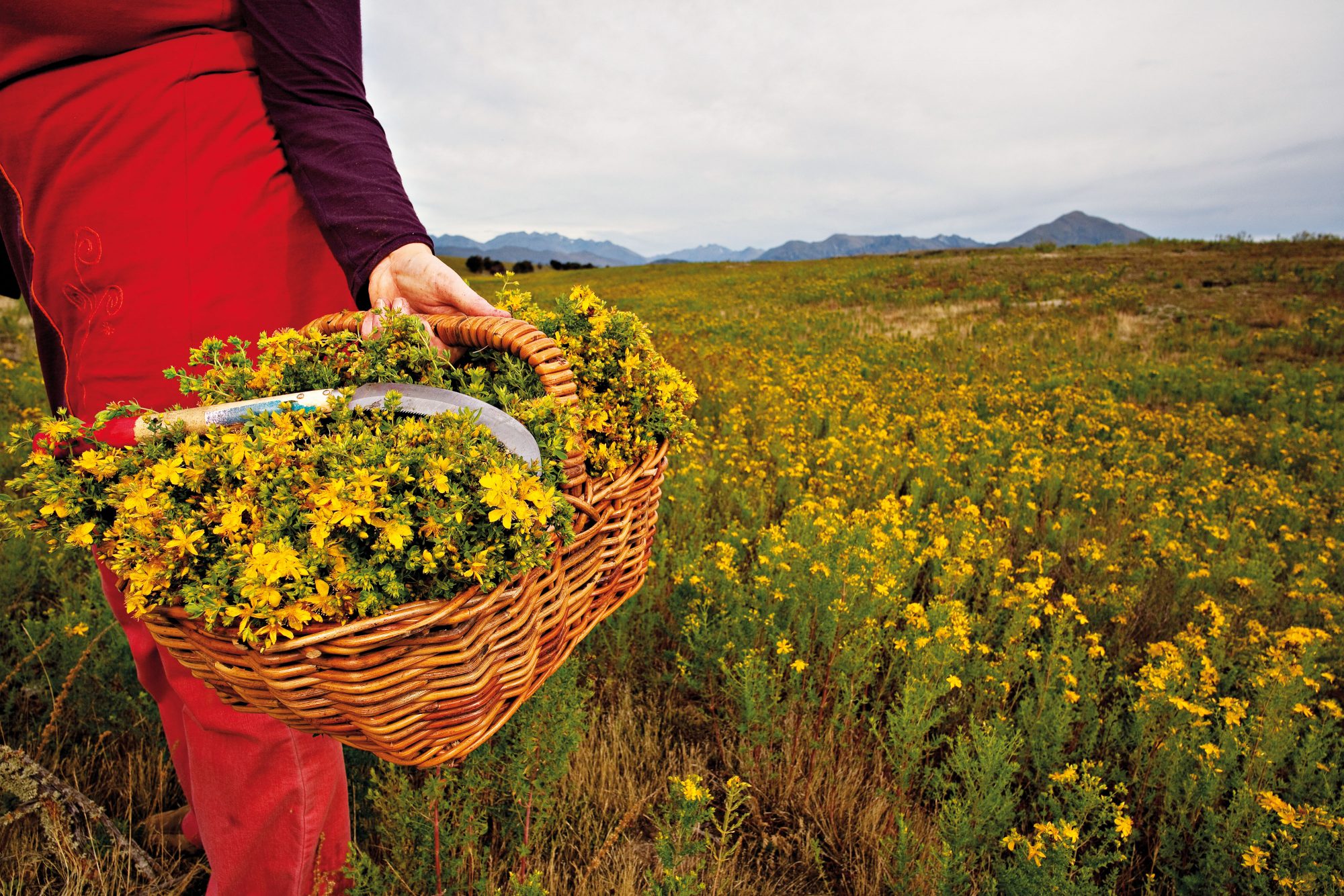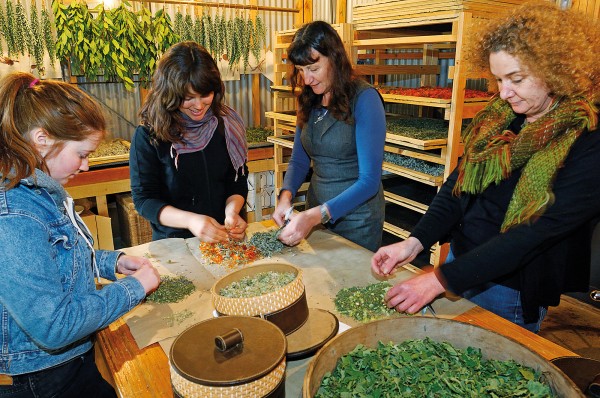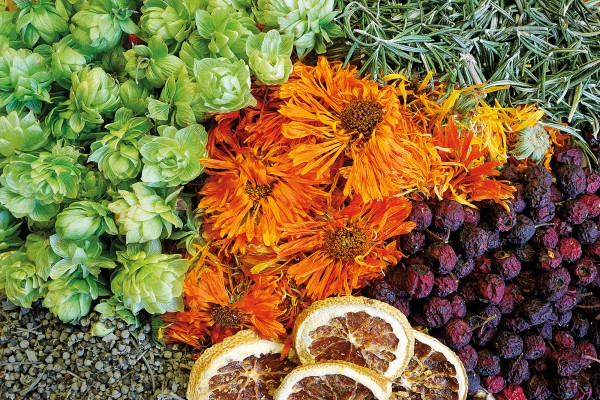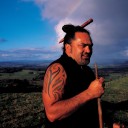
Fields of Plenty
Look closer. The straggling plants on the riverbank, the so-called weeds in the garden, the insect-eaten leaves on the forest’s edge—often ploughed, sprayed or simply ignored—are finding their way back into the medicine chest. And Māori herbal remedies, once derided and outlawed by an act of Parliament, are revealing their curative power.
Sandra Clair holds the stem of a small yellow flower. We’re standing on the muddy edge of a floodplain about ten minutes’ drive out of Wānaka, a sodden, scruffy plateau under the hulking presence of the Cardrona mountains.
Clair points to the minuscule perforations on the petals and leaves. She shows me the roundness of the stem and how, if she rubs the petals with her fingers, her skin is stained red. Evidence, she says, that this is St John’s Wort, one of 13 different varieties of Hypericum now outselling Prozac in Europe as a remedy for mild to moderate depression and anxiety.
“It is a great friend of mine,” says Clair. “A fabulous plant. It’s energy-giving. It’s liquid sunshine. I remember the first time I saw it here, I almost cried.”

Clair is a medical herbalist, trained in the mountains of Switzerland and the universities of Berne and New England, founder of Artemis, a Dunedin-based enterprise making plant-based oils, creams, tinctures, balms and medicinal loose-leaf teas (a different creature altogether, she says, from the pulverised contents of most supermarket herbal teabags) as a basic maintenance kit to treat common ailments and boost the body’s ability to ward off illness.
Two weeks ago, Clair was here with Artemis staff and friends, collecting flowers and stems to be processed into a strong, blood-red oil or to be dried for tea.
This is the tradition of wild-crafting—an age-old practice of harvesting plants in their natural environment, a science long dependent on proper identification, an appreciation of sustainability and an understanding of when the plant’s active constituents are at their strongest.
“Not too early,” says Clair, “and not too late. It’s like wine, or cherries.”
[Chapter Break]
The drive through Lindis Pass to Wānaka is a succession of photo stops: the pencil-pale peaks of Aoraki/Mount Cook, the icy blueness of Lake Tekapo, the expanses of tussock cloaking the foothills. Cut out of the frame, however, is the disorderly profusion of plants crowding the riverbanks and hillsides in the foreground: yarrow the wound-healer (its Latin name, Achillea millefolium, is taken from the story of Greek hero Achilles’ narrow escape from Paris’ arrow thanks to the properties of this ubiquitous plant), rosehip, thyme, St John’s Wort, elderflower, hawthorn—a miscellany of weeds, trees and flowers introduced by early goldminers as a living first aid kit, by European settlers as culinary or medicinal herbs or ornamental plants, or arriving as rogue seeds in imported grass mixes imported from around the world.
Thriving in the hard light, a climate that sears Central Otago in summer, freezes it in winter, this wild medicine chest is healthy, strong, vibrant.
“The herbs here are outstanding,” says Clair. “And we really need to make more of a noise about it.”
Older than the yarrow on the Lindis Pass, older than the elderflower trees on the road to Alexandra, the use of plants to treat ailments has a long and largely unbroken history.
“If you condense the history of human medicine into a relative period of one year,” says Phil Rasmussen, pharmacist, medical herbalist, founder of Phytomed Medicinal Herbs and manufacturer of the Kiwiherb range of herbal extracts and tinctures, “everything except for the last minute was dominated by herbal medicine.”

For early Māori, the bush was well stocked with remedies for the treatment of disease and injuries. While the earliest European doctors, chemists or “compounders of vegetable medicines” relied on imported dried herbs, sold on the goldfields from “canvas stores” or through the fledgling network of dispensaries, many were keen to include native plants in their practices. In The New Zealand Family Herb Doctor, published in 1891, herbalist James Neil described mānuka (“a well-tried and approved diuretic”), koromiko, horopito, pohutukawa and harakeke (for ringworm and dysentery) as among New Zealand’s most valuable herbs.
As physician Robert Fulton wrote in 1922, “When [the English medical practitioner’s] scanty stock of drugs failed him, he turned to the Maoris for some of their medical lore and knowledge.” (Fulton in turn treated Māori “writhing in apparent agony” with a bolus of “powdered opium and butter”).
But a list of native plants and their respective uses? Teacher, ecologist and practitioner of traditional medicine Rob McGowan sidesteps the question. As with many indigenous approaches to medicine, he says, rongoā, the traditional healing system of Māori, involves a more holistic approach to health.
“The foundation of Māori medicine isn’t in plants, it’s in wairua. Its basis is spiritual. Often the sicknesses we get derive not from the bugs we encounter but from the feeling within us, which science is beginning to demonstrate has a direct effect on our immune system. If you just worry about the physical symptoms you might be starting in the wrong place.”
In the largely unregulated heath sector of the late 18th and early 19th centuries, rongoā Māori was one of a number of healing practices on offer. Herbalism, Chinese medicine, hydrotherapy, acupuncture, homeopathy and Western medicine were all available to augment traditional systems of family healthcare—including the ubiquitous mustard poultice—handed down through generations.

Despite its popularity, however, herbalism and rongoā Māori had—and continue to have—their detractors. In 1907, Neil, then president of the fledgling New Zealand Association of Medical Herbalists (NZAMH), petitioned Parliament for legal status for herbalists. He was unsuccessful. According to one letter-writer to the Evening Post, “The stewer of drugs is obsolete.”
In 1939, faith healer-turned-herbalist Bill Anderton—a Labour MP for 25 years and grandfather of 1984–88 finance minister Roger Douglas—applied again for separate registration. A government compromise, whereby registered medical herbalists would be dependent on GP referral, was declined. According to former NZAMH president Joan Flynn, Anderton recognised that, while herbal medicine can be complementary to orthodox medicine, “it can also provide a complete alternative for many patients”.
Traditional Māori medicine faced a more determined challenge.
The Medical Practitioners Registration Act 1869 and the Tohunga Suppression Act 1907—pitched, says McGowan, at the emerging “messianic” movements rather than traditional methods of healing—succeeded in restricting traditional herbal practice or pushing it underground.
Whare wananga disappeared, knowledge was lost.
[sidebar-1]
For a brief period in mid-20th century New Zealand, herbal medicine was largely ignored, shunned by the majority of the medical profession, absent from medical school curricula, relegated to pot-pourri classes and a few fringe clinics and alternative health food stores.
But a centuries-old tradition was not going to go quietly. In the 1980s, the practice of herbalism began to gain wider attention. The NZAMH was revived and courses in herbal medicine began to appear. In 1990, Isla Burgess launched the Waikato Centre for Herbal Studies, with its own herb gardens and a holistic approach to a subject steeped in the ancient cultures of wise women, the “green witches”, seasonal rituals and conservation.
But how to align the whole-earth, nature-loving thinking of plant-based medicine with the scientific gravitas required to further understanding (and sales) within the general population? For many years, proof of the efficacy of herbal medicine was undermined by a lack of scientific interest, the failure of many studies to take into account the differences between, say, chamomile grown in Scotland and harvested in autumn and that grown in Northland and harvested in spring; and the resistance of whole-plant remedies to be broken down to a single this-cures-that equation. (Scientists are still trying to identify the constituents that render that small yellow flower with the pock-marked petals such an effective remedy for mild depression.)
“Herbal medicine nudges the innate healing capabilities of the body back to wellness,” says Burgess, currently running a post-graduate course for the International College of Herbal Medicine. “That nudging happens at a fundamental level, a cellular level. We can say, yes, Hypericum has an impact on neurotransmitters, but it has a far greater effect than that. Underneath that linear, scientific view—you take this herb and this is the result—is something far more complex. In a holistic practice of herbal medicine we look at the person in all their manifestations of health and disease.”
[Chapter Break]
Today, the mantras of herbalists and naturopaths in the 1980s—eat a varied diet, include lots of fresh fruits and vegetables, recognise stress, even take folic acid during pregnancy—are de rigueur in GP clinics. Trained herbalists offer a range of practitioner-only herbal supplements, teas, foul-smelling extracts and tinctures, and research into herbal medicines is growing exponentially. Natural health products are big sellers in pharmacies, pharmaceutical companies are buying up natural supplement brands or developing their own (Bayer, GlaxoSmithKline and Novartis all sell plant-based supplements) and ‘ethno-botanists’ are scouring the planet for ‘new’ (read patentable) health-promoting plants.
In 1995, regional health authorities were given permission to purchase aspects of rongoā Māori. Just over a decade later, the Ministry of Health released a rongoā development plan outlining how Māori traditional healing practices could work within the health and disability sector.
More GPs are advocating herbal remedies, and medicinal herbalism is back in medical school curricula.
“Young medical students and most young doctors recognise that herbal medicine is increasingly evidence-based and that robust clinical trials show that it is generally safe—safer in most cases than drugs,” says Phil Rasmussen. “It doesn’t do everything but there’s a lot it does do, particularly in terms of preventive health care.”
It is also, he says, a very cost-effective model.
“We have an ageing population. Governments globally are being constrained with health expenditure budgets, and new drugs in the pipeline are getting increasingly expensive, with fewer truly innovative advancements in drugs coming on the market.”
Which leaves the door wide open for New Zealand to develop a herb industry based on the excellent growing conditions and expertise in this country. As Rasmussen says, “New Zealand is a growing nation, that’s our forte, and it’s not just pine trees and Chinese gooseberries—you name the plant, you name the herb, where there’s a bit of agronomy and some research input we grow the best in the world.”

Some of that research has been done. In the 1980s, the Government initiated a new crop research programme applying robust science to the market potential of high-value, specialised crops, including essential oils, medicinal herbs, edible fungi, Chinese herbs and native ornamentals. It was, says agronomist Malcolm Douglas, a decade of vibrant activity. “We had the whole medicinal suite: St John’s Wort, arnica, tarragon, sage, thymus, oreganum, mint, liquorice, the angelicas. We were pulling in seeds from all over the world.”
Despite competition from low-cost labour countries such as Egypt and China, the result, he says, was “a clear indication that a wide range of medicinal herbs and essential oils should be able to be grown successfully in New Zealand”.
Our growing conditions are good, the science is sound, and there is no shortage of rural lifestylers looking for a new home-based income stream.
Take arnica, a popular pharmaceutical and medicinal herb used to treat bruises, sprains, fractures and joint problems. Traditionally collected by Romany communities in Europe, it is now in high demand as northern supplies diminish and interest in the capabilities of the small alpine plant continues to grow. A 2008 report for Plant & Food Research by Douglas and Bruce Smallfield concluded that New Zealand “has a good opportunity to commercially cultivate arnica flowers and roots for the international markets”.
[sidebar-2]
The research programme helped to launch the saffron industry and gave the Central Otago wine industry a productive push, but the potential for an export industry based on high-quality, scientifically endorsed medicinal herbs was shot down in mid-flight when, in 1998, funding was pulled from the programme. New biosecurity legislation in the late 1990s added further restrictions. Based, says Douglas, “on a whole lot of fallacious views about weed invasion”, the Hazardous Substances and Noxious Organisms Act 1996 allows only plants already on the Ministry of Agriculture and Forestry list of acceptable species (based on species already here) to be imported into the country. Those not on the list require an assessment by the Environmental Protection Authority. For plants likely to form self-sustaining populations this comes at a cost of around $30,000.
“Pinus radiata, kiwifruit, grapes, asparagus—these are all plants producing major income streams for New Zealand,” says Douglas. “Under current regulations, if they were not already here, they would certainly all be denied entry into New Zealand because of their prolific seed production.”
Exports based on local plants have had more success.
Mānuka (Leptospermum scoparium) has long been valued by Māori for its powerful antibacterial and antifungal properties. Recent research has found that mānuka growing in a small area of the East Cape of the North Island has unusually high levels of the active triketone chemotype, making the resulting oil many times more active than Australian tea tree oil in the treatment of skin irritation and infections. Based in the small township of Te Araroa, Tairawhiti Pharmaceuticals Ltd now exports the high-quality mānuka oil to Japan, Korea, the United Kingdom and Europe.

Recent findings on the healing properties of horopito, traditionally used by Māori and European settlers for ringworm, bruises, wounds, cuts and toothache, have also found the plant to be effective against the yeast infection Candida albicans. Forest Herbs Research in Golden Bay is now using organically farmed horopito to make a range of medicinal products for export.
A growing issue for any export-oriented herbal medicine producer is internationally recognised certification. Rasmussen’s Phytomed and Kiwiherb ranges of extracts and tinctures are produced under the globally recognised Good Manufacturing Practice (GMP) certified manufacturing standard. Clair’s Artemis range is certified organic through AssureQuality (a Government-owned quality assurance company dealing with food safety and biosecurity) and made on GMP-approved premises. Such assurance is expensive, but it is also necessary.
“I’m passionate about New Zealand as a source of finished products that we export to the world,” says Clair. “I believe this industry has the potential to be a huge contributor to our national economy. But if you don’t have a regulatory stamp of approval that is internationally recognised you just don’t get there.”
Moves to launch a joint Australia-New Zealand agency to regulate therapeutic products under a single licensing process have recently been revived after being shelved in 2007 through a lack of support in Parliament. While the new Natural Health Products Bill is expected to provide a New Zealand-based framework in terms of labelling requirements, certification and product approval, there are suggestions that, further down the track, such products may be included in the joint scheme.
Some argue that tighter regulations would add prohibitive costs to small manufacturers—a change, says Clair, “that would not add to the efficacy or safety of a product”. Others argue it would provide the level of assurance necessary for both the local and export market. It’s a global trend, says Rasmussen, “and you can’t hide from it.”

Some herbs, he says, should require a prescription from a suitably qualified medical herbalist or doctor. “You shouldn’t be able to go to Countdown and buy St John’s Wort, for example. It can interact seriously with about a dozen pharmaceutical drugs, and clinical depression can be a life-threatening illness.”
Equally contentious is the potential for commercial exploitation of indigenous knowledge and native plants. While plants or parts of plants as found in nature cannot be patented, isolated ‘active ingredients’ or plant substances involving an element of invention can be. In 1991, six iwi lodged the Wai 262 (Flora and Fauna) Claim with the Waitangi Tribunal. The claim addressed a range of intellectual property-related concerns including the release of genetically modified indigenous plants, the export of native species and the question of patents and the extinction of wild species. While the resulting report, released in July, does not give Māori ownership of taonga species or automatic right of veto over intellectual property applications over those species, iwi or hapū interests will be taken into account through a new Māori advisory committee, a register of taonga species and new powers by the Commissioners of Patents and of Plant Variety Rights to refuse patents that interfere with the relationship between kaitiaki (those hapū or iwi with specific roles of guardianship) and the plant species in question.
Concerns over the sustainability of medicinal plants are not confined to New Zealand. As the New Scientist reported in 2009, globally between 15,000 and 50,000 medicinal plants are under threat of extinction. The ramifications of such loss are huge, says Burgess, who is part of the International Research Group for the Conservation of Medicinal Plants.
“More than 400,000 tonnes of medicinal and aromatic plants are traded in the world each year. The great majority of these are harvested from the wild so they each have an impact on their local ecosystem and the people that depend on it.”
She gives the example of elm trees in the US, ring-barked and stripped for the growing market for slippery elm. Here again New Zealand could play a role—a safe haven, says Rasmussen, for endangered plants, “but the current regulations don’t allow free access of this material into the country”.
[sidebar-3]
Back in Wānaka, Clair stops beside a wide and barren landscape. It is fenced, levelled, signposted with a bullet-point list of real estate hyperbole. This is prime property—great views, clean air, nearby schools and not a traffic light in sight. Just two years ago, says Clair, it was awash with the nodding yellow heads of St John’s Wort.
“The biggest problems people have these days are stress and pain, and here we have St John’s Wort, the one plant that is ideally suited to take care of both. Yet we allow our landscape to be built on and the rest is eroded through dramatic changes of weather. Without realising it we have fewer and fewer places to harvest our medicines from. In terms of landscape planning we need to take care to protect access to medicinal plants.”
McGowan, too, is concerned. Many of the indigenous plants used medicinally, he says, grow on the edges of forests, areas under threat by agriculture and housing developments. Kumarahou, for instance, was traditionally used for chest and kidney complaints. Once, he says, it grew prolifically in Welcome Bay, near Tauranga, “but it has long since gone. The land has been taken over by housing and farming and kiwifruit orchards. I spent all day driving around with my binoculars and didn’t find one. We need to reintroduce plants that were historically present, using stock sources.”
Such plants are necessary, he says, not just for human health but also for the health of the land.
“If Papatūāƒmaoinuku is well, she can look after you. If she is not well, all the kids are going to get sick. We need to heal the land. We need to plant trees so the birds come back, then the birds will plant the seeds for us. Most plants access nutrients through micro-organisms, and if land practice destroys those micro-organisms, the plants will be lost. Those are the things that we are beginning to learn. Instead of worrying about how terrible things are for us we should say, hey, look at our sick rivers.”
For Burgess, this learning begins at home, in the domestic garden where many of our most important medicines, she says, can be found.
“Using plants from your garden in your food as a primary source of healthcare, I would really encourage that. Fat hen, it grows as a weed but it’s edible and very nutritious. Dandelion, don’t spray it, eat it! Sage is a good antioxidant, and right now people are researching thyme’s antioxidant properties.”
[Chapter Break]
It is late autumn. On a gently-sloping property in the beautiful Okuti Valley on Banks Peninsula, the dark red cones of Echinacea are losing their petals, and the mugwort is looking straggly. Yesterday, Valmai Becker, medical herbalist, teacher and former director of Christchurch’s College of Natural Medicine, spent the day harvesting dandelion root. Sage is next, then marshmallow. But still the garden is green with soft-leafed mullein, lemon balm, globe artichoke, red clover, feverfew, yarrow, ginkgo trees, calendula and withania (used in ayurvedic medicine to lower cholesterol).
In the drying room, boxes and bags of hops, sharp-smelling peppermint and blue hyssop crowd the bench. In the kitchen there are freshly made oils, creams and balms. These are Becker’s classrooms, where she introduces people to the age-old practice of planting, harvesting and processing easily grown herbs as a primary source of healthcare.
“The medicines that you need are around you,” she says. “This is where the healing comes from. It doesn’t cost a fortune and the fact of doing it is hugely important.”

This is barefoot doctoring, garden medicine, a system of healing based on rosemary in the garden, lemon verbena on the deck, comfrey in the community allotment, used not only for treating ailments but in resisting disease—a holistic practice, says Burgess, based on an understanding of, and respect for, traditional whole-plant therapy. “And you can’t learn that in a six-week course.”
While the Government has finally agreed that medical herbalism should be regulated under the Health Practitioners Competency Assurance Act (the NZAMH is currently having to re-apply under the revised provisions of the legislation), a groundswell of interest in the healing abilities of whole-plant-based medicine, says Burgess, is already underway.
“The practice of herbal medicine is already in the hearts and minds of people. It’s continuing in the conventional ways through education, and more people are looking at what plants grow around them and the use of those. Nothing is going to stop that.”



















